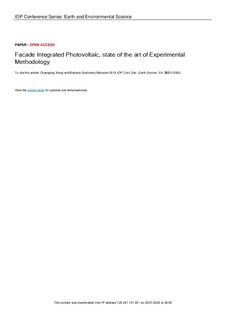| dc.contributor.author | Xiang, Changying | |
| dc.contributor.author | Matusiak, Barbara Szybinska | |
| dc.date.accessioned | 2020-01-29T08:06:23Z | |
| dc.date.available | 2020-01-29T08:06:23Z | |
| dc.date.created | 2020-01-06T11:12:42Z | |
| dc.date.issued | 2019 | |
| dc.identifier.issn | 1755-1307 | |
| dc.identifier.uri | http://hdl.handle.net/11250/2638454 | |
| dc.description.abstract | The concept of Building-integrated Photovoltaics (BIPV) is one of the most promising strategies to employ clean energy in the built environment. Up to now, the PVs have been applied mostly on roofs, but since the total roof area is insufficient, there is a need to integrate photovoltaics on building façades as well. This challenges not only the architectural design of a single building but also the visual image of urban environment, as photovoltaics have to harmonize with conventional building materials used on building facades as brick, concrete, wood, etc. Aiming to provide a foundation for research exploring facade-integration methods that will ensure successful architectural result, the paper presents a state of the art on façade integrated photovoltaics (FIPV) with focus on the experimental research methodology. It embraces both, theoretical research and PVs applications in building projects. As pure computer simulations are not recognized as an experimental methodology, papers conveying such generated results have not been included. In addition, the research that deals exclusively with energy aspects is omitted. The study is based on a comprehensive literature review. Advanced experimental methodologies from selected literature are described and categorized according to the scale (building or urban) and the transparency of the PVs (opaque or translucent). Then detailed features of PV experimental methods are demonstrated in structured tables for analysis and discussion. The study shows that even though solid scientific methods are used to evaluate single features of PVs, e.g. colour or reflectance, there is an obvious lack of methodology providing holistic assessment of Façade-integrated Photovoltaics, especially at the urban scale. The further research will lead toward developing of evaluation criteria framework (in interdisciplinary cooperation) and then provide a holistic methodology combining qualitative and quantitative methods for a successful FIPVs in urban context. | nb_NO |
| dc.language.iso | eng | nb_NO |
| dc.publisher | IOP Publishing | nb_NO |
| dc.rights | Navngivelse 4.0 Internasjonal | * |
| dc.rights.uri | http://creativecommons.org/licenses/by/4.0/deed.no | * |
| dc.title | Facade Integrated Photovoltaic, state of the art of Experimental Methodology | nb_NO |
| dc.type | Journal article | nb_NO |
| dc.type | Peer reviewed | nb_NO |
| dc.description.version | publishedVersion | nb_NO |
| dc.source.volume | 352 | nb_NO |
| dc.source.journal | IOP Conference Series: Earth and Environmental Science (EES) | nb_NO |
| dc.source.issue | 1 | nb_NO |
| dc.identifier.doi | 10.1088/1755-1315/352/1/012062 | |
| dc.identifier.cristin | 1766677 | |
| dc.description.localcode | Content from this work may be used under the terms of theCreative Commons Attribution 3.0 licence. Any further distribution of this work must maintain attribution to the author(s) and the title of the work, journal citation and DOI. Published under licence by IOP Publishing Ltd | nb_NO |
| cristin.unitcode | 194,61,55,0 | |
| cristin.unitname | Institutt for arkitektur og teknologi | |
| cristin.ispublished | true | |
| cristin.fulltext | postprint | |
| cristin.qualitycode | 1 | |

